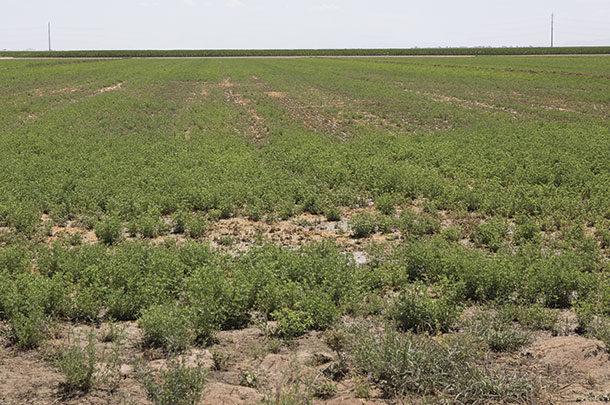Dryland alfalfa is a different story.
We have visited alfalfa fields planted by a generation of farmers who have long been deceased that are still being harvested by grandchildren and great-grandchildren (at least 10 to 20 years). On one memorable farm visit, we determined most of the green material in the field was some species other than alfalfa (usually weeds).
We conducted a test to see if we could place the toe of our boot on one alfalfa plant and, while lying prone on the ground, rotate in a complete circle (360 degrees) and have any part of our body touch another alfalfa plant. When no other plants were contacted, we determined the old adage “When the horse is dead, get off” applied to this field.
There is almost nothing more exciting than the smell of diesel, the thrill of a powerful piece of equipment and the chance to drive across an entire field. Continuing to swath and bale this field, however, definitely fell into the category of recreational farming.
Over a period of many years, we have come to believe the decision to take an alfalfa stand out of production should include consideration of the following rules of thumb:
1. Plant population – At stand establishment, an acceptable seeding of new alfalfa should have more than 25 plants per square foot. As the stand ages, the number of plants per square foot declines. Mick Canevari, Dan Putnam (UC – Davis) and Dan Undersander (Wisconsin) have monitored the number of alfalfa stems per square foot as it relates to yield.
They found alfalfa stands with more than 55 stems per square foot have 100 percent yield potential. However, populations of 40 to 55 stems will result in some yield reduction, and fields with less than 39 stems per square foot should be replaced.
Plants per square foot can also serve as an estimator of stand productivity. If an alfalfa stand has fewer than four to six plants per square foot, it should be replaced. Plants per square foot can be easily estimated by using the “ball cap” method.
We have measured the surface area under a standard ball cap (does not apply to cowboy hats). On average, the area under a cap (including the bill) is half a square foot. To make a field estimate, a grower can throw their hat randomly into the field and count the number of plants it covers. If the hat covers fewer than two or three plants, the stand is too poor to continue in production and should be removed.
2. Economics – If the price of alfalfa hay is high, then a reduced yield may still make economic sense to continue harvesting a poor stand, particularly if sales are based on tons per acre and not quality.
3. Weeds – If the population of weeds in the field is high, and appears to be getting worse, it is time to remove the stand.
4. Diseases – If the variety of alfalfa growing in the field is susceptible to locally common diseases, and the stand is not thrifty, then it makes sense to rotate the crop and reseed in the future with a more adapted variety.
5. Insects – When insect populations reduce alfalfa yields below the acceptable economic threshold and seem to be getting worse, it is time to remove the alfalfa and move into a suitable rotation crop.
6. Overseeding with alfalfa – When a stand begins to decline, there is a temptation to overseed the field with more alfalfa. Allelopathy (the production of a chemical by one plant that inhibits the growth of another) and uniquely in alfalfa “autoallelopathy” (the production of a chemical by alfalfa plants that inhibits the growth of other alfalfa plants) makes overseeding existing alfalfa fields with more alfalfa seed almost always a failure.
To avoid the problems with allelopathy, rotate to another crop and stay out of alfalfa for at least one year and preferably two. Crop rotation also aids in weed, insect and disease control.
7. Overseeding with other crops – It is possible to stretch the life of a declining alfalfa stand by overseeding with cereals, grasses (such as annual ryegrass, bromegrass, orchardgrass, perennial ryegrass or tall fescue), or perhaps another legume – but not alfalfa.
Before overseeding, it is necessary to determine the length of time the field will stay in production after overseeding. If one year is the expected increased life of the stand, then overseeding with an annual crop will be acceptable. If the overseeding is going to be productive for more than one year, then a perennial crop should be used.
No matter how important an alfalfa stand has been to the farming operation, at some point it will become necessary to say goodbye. Understanding at the time of planting alfalfa stands are not productive for eternity makes it easier to spray one out or plow one down. ![]()
PHOTO: Alfalfa can last for generations, but that doesn’t mean it should. Photo by Mike Dixon.
Earl Creech is an extension agronomist at Utah State University. Email Earl Creech.
Ralph Whitesides is a retired professor and extension weed specialist from Utah State University.











